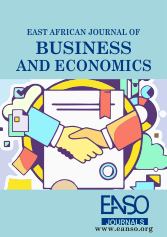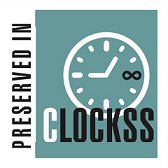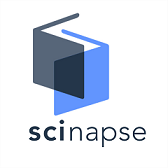Cross-Level effects of High-Performance Work Systems on the Innovative Work Behaviours of Employees: The Role of Future Time Perspectives
Abstract
This study assesses the mediating role of future time perspective in the relationship between high-performance work systems and innovative work behaviours of employees in Tanzania’s banking sector. Drawing from AMO theory, social exchange theory, and socio-emotional selectivity theory, we hypothesise that, first, the utilisation of high-performance work systems in an organisation is positively associated with future time perspective; second, the utilisation of high-performance work systems in an organisation is positively associated with the innovative work behaviours of employees in the organisation, and third, future time perspective mediates the relationship between high-performance work systems and innovative work behaviours of employees in a workplace. The findings of this cross-level study constitute 152 respondents from the company level (business unit level) and 220 respondents from the employee level. The results provide empirical evidence that high-performance work systems have a significant and positive effect on future time perspective, high-performance work systems have a positive and significant effect on innovative work behaviour and, importantly, future time perspective has a partial mediation in the relationship between high-performance work system and innovative work behaviour. The practical implications of the study are that managers need to effectively implement HPWS practices to encourage employees to be innovative as mediated by their perception of future prospects. Through this adoption and utilisation of HPWS, organisations can enhance innovative work behaviours amongst employees and therefore organisational performance.
Downloads
References
Abstein, A., & Spieth, P. (2014). Exploring HRM meta-features that foster employees’ innovative work behaviour in times of increasing work-life conflict. Creativity and Innovation Management, 23(2), 211–225. https://doi.org/10.1111/caim.12053
Amankwaa, A., Gyensare, M. A., & Susomrith, P. (2019). Transformational leadership with innovative behaviour: Examining multiple mediating paths with PLS-SEM. Leadership and Organization Development Journal, 40(4), 402–420. https://doi.org/10.1108/LODJ-10-2018-0358
Andre, L., van Vianen, A., Peetsma, T., & Oort, F. (2018). Motivational power of future time perspective: Meta-analyses in education, work, and health. In Plos One (Vol. 13, Issue 1). https://doi.org/10.1371/journal.pone.0190492.t007
Beltrán-Martín, I., Bou-Llusar, J. C., Roca-Puig, V., & Escrig-Tena, A. B. (2017). The relationship between high-performance work systems and employee proactive behaviour: role breadth self-efficacy and flexible role orientation as mediating mechanisms. Human Resource Management Journal, 27(3), 403–422. https://doi.org/10.1111/1748-8583.12145
Bos-Nehles, A., Renkema, M., & Janssen, M. (2017). HRM and innovative work behaviour: a systematic literature review. Personnel Review, 46(7), 1228–1253. https://doi.org/10.1108/PR-09-2016-0257
Boxall, P., & MacKy, K. (2009). Research and theory on high-performance work systems: Progressing the high-involvement stream. Human Resource Management Journal. https://doi.org/10.1111/j.1748-8583.2008.00082.x
Brockner, J., Flynn, F. J., Dolan, R. J., Ostfield, A., Pace, D., & Ziskin, I. V. (2006). Commentary on “radical HRM innovation and competitive advantage: The Moneyball story.” Human Resource Management, 45(1), 127–145. https://doi.org/10.1002/hrm
Carstensen, L. L. (2006). The influence of a sense of time on human development. Science, 312(5782), 1913–1915. https://doi.org/10.1126/science.1127488
Fu, N., Flood, P. C., Bosak, J., Morris, T., & O’Regan, P. (2015). How do high-performance work systems influence organisational innovation in professional service firms? Employee Relations, 37(2), 209–231. https://doi.org/10.1108/ER-10-2013-0155
García-Chas, R., Neira-Fontela, E., & Varela-Neira, C. (2019). High-Performance Work Systems and Work-Role Performance: A Multilevel Moderated Mediation Model. Performance Improvement Quarterly, 32(1), 77–101. https://doi.org/10.1002/piq.21289
Henry, H., Zacher, H., & Desmette, D. (2017). Future time perspective in the work context: A systematic review of quantitative studies. Frontiers in Psychology, 8(MAR). https://doi.org/10.3389/fpsyg.2017.00413
Huang, Y., Ma, Z., & Meng, Y. (2018). High-performance work systems and employee engagement: empirical evidence from China. Asia Pacific Journal of Human Resources, 56(3), 341–359. https://doi.org/10.1111/1744-7941.12140
Husin, N. H., Naha, N., Mansor, A., Widarman, B., & Kelana, Y. (2021). The Influence of High-performance Work Systems (HPWS) On Innovative Work Behaviour Through Work Engagement. Journal of Contemporary Issues …, 27(2), 5408–5424. https://doi.org/10.47750/cibg.2021.27.02.548
Jyoti, J., & Rani, A. (2017). High-performance work system and organisational performance: role of knowledge management. Personnel Review, 46(8), 1770–1795. https://doi.org/10.1108/PR-10-2015-0262
Kooij, D. T. A. M., Kanfer, R., Betts, M., & Rudolph, C. W. (2018). Future Time Perspective: A systematic review and meta-analysis. Journal of Applied Psychology, 103(8), 867– 893. https://doi.org/10.1037/apl0000306
Korff, J., Biemann, T., & Voelpel, S. C. (2017). Human resource management systems and work attitudes: The mediating role of future time perspective. Journal of Organizational Behavior, 38(1), 45–67. https://doi.org/10.1002/job.2110
Messersmith, J. G., Kim, K. Y., & Patel, P. C. (2018). Pulling in different directions? Exploring the relationship between vertical pay dispersion and high-performance work systems. Human Resource Management, 57(1), 127–143. https://doi.org/10.1002/hrm.21846
Mihail, D. M., Links, M. Mac, & Sarvanidis, S. (2013). High-performance work systems in corporate turnaround: A German case study. Journal of Organizational Change Management, 26(1), 190–216. https://doi.org/10.1108/09534811311307978
Min, M., Zhu, Y., & Bambacas, M. (2019). The mediating effect of trust on the relationship between high-performance work systems and employee outcomes among Chinese indigenous firms. Asia Pacific Journal of Human Resources, February, 37–41. https://doi.org/10.1111/1744-7941.12221
Sanz-Valle, R., & Jiménez-Jiménez, D. (2018). HRM and product innovation: does innovative work behaviour mediate that relationship? Management Decision, 56(6), 1417–1429. https://doi.org/10.1108/MD-04-2017-0404
Shah, A. U., & Ishfaq Khan, M. (2019). HRM-Performance Perspectives: An overview of Theoratical Challenges and Prospects. Engineering Economics, 30(3), 382–393. https://doi.org/10.5755/j01.ee.30.3.9550
Tang, G., Yu, B., Cooke, F. L., & Chen, Y. (2017). High-performance work system and employee creativity: The roles of perceived organisational support and devolved management. Personnel Review, 46(7), 1318–1334. https://doi.org/10.1108/PR-09-2016-0235
Tracey, J. B., Berryman, P., Lukes, E., Brunson, D. A., Vogt, J. F., Honold, L., Kieffer, C. H., Thomas, K. W., Velthouse, B. A., Menon, S. T., Lee, M., Koh, J., Sarmiento, T. P., Laschinger, H. K. S., Iwasiw, C., Laschinger, H. K. S., Kuokkanen, L., Leino-kilpi, H., Spreitzer, G. M., … Ashforth, B. E. (2016). The effect of employee skills, behavior and human resource practices flexibility on firm performance: Perceived ... 31(January), 622–640. https://doi.org/10.1177/1038411107082273.262
Veenendaal, A., & Bondarouk, T. (n.d.). Perceptions of HRM and its effect on dimensions of innovative work behavior. 26(2), 1–34. https://doi.org/10.1688/mrev-2015-02-
Yang, W., Nawakitphaitoon, K., Huang, W., Harney, B., Gollan, P. J., & Xu, C. Y. (2018). Towards better work in China: mapping the relationships between high-performance work systems, trade unions, and employee well-being. Asia Pacific Journal of Human Resources, August. https://doi.org/10.1111/1744-7941.12205
Copyright (c) 2023 Samuel Kiplangat Ngetich

This work is licensed under a Creative Commons Attribution 4.0 International License.




























